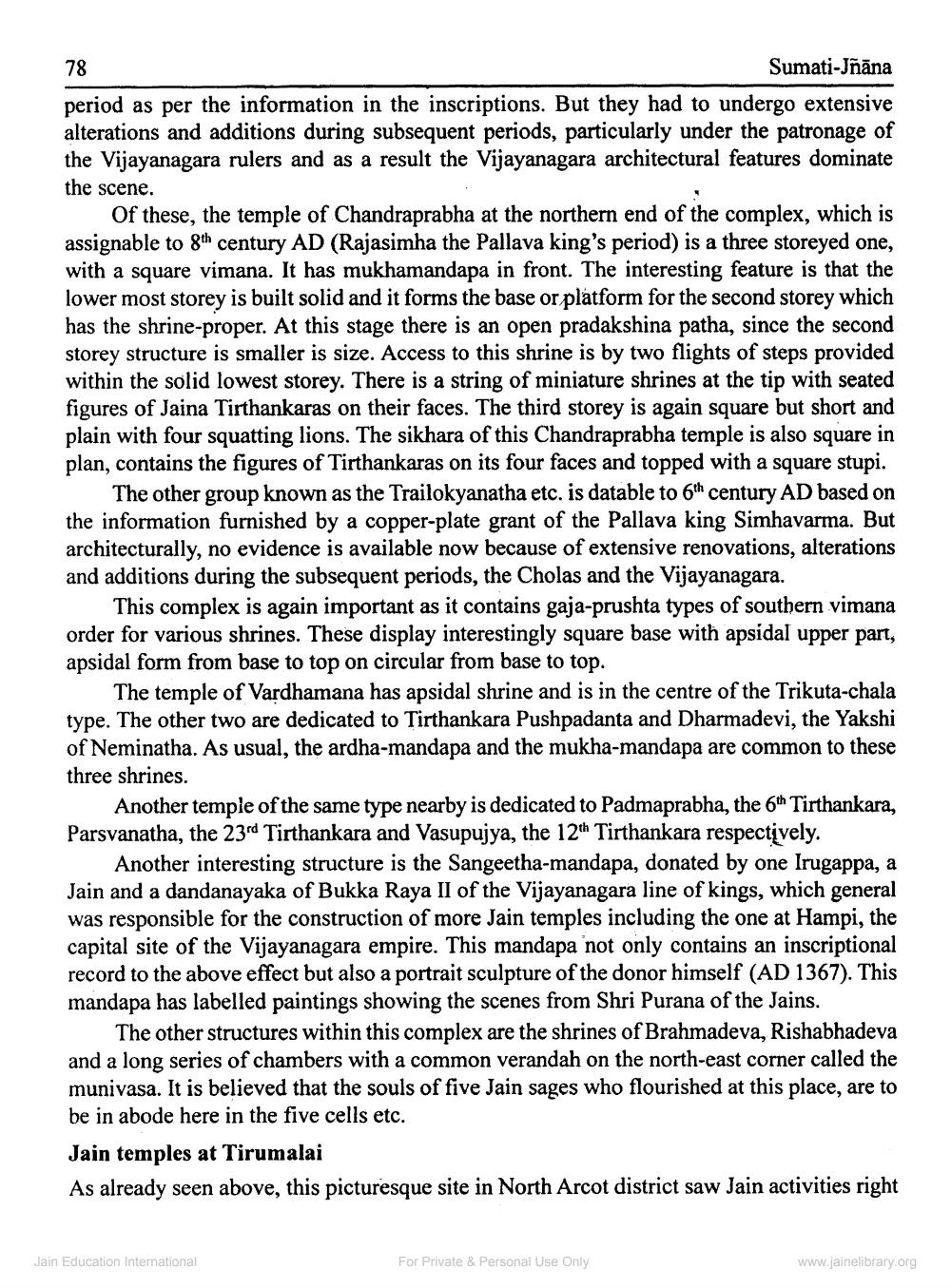________________
78
Sumati-Jñāna period as per the information in the inscriptions. But they had to undergo extensive alterations and additions during subsequent periods, particularly under the patronage of the Vijayanagara rulers and as a result the Vijayanagara architectural features dominate the scene.
Of these, the temple of Chandraprabha at the northern end of the complex, which is assignable to gth century AD (Rajasimha the Pallava king's period) is a three storeyed one, with a square vimana. It has mukhamandapa in front. The interesting feature is that the lower most storey is built solid and it forms the base or platform for the second storey which has the shrine-proper. At this stage there is an open pradakshina patha, since the second storey structure is smaller is size. Access to this shrine is by two flights of steps provided within the solid lowest storey. There is a string of miniature shrines at the tip with seated figures of Jaina Tirthankaras on their faces. The third storey is again square but short and plain with four squatting lions. The sikhara of this Chandraprabha temple is also square in plan, contains the figures of Tirthankaras on its four faces and topped with a square stupi.
The other group known as the Trailokyanatha etc. is datable to 6th century AD based on the information furnished by a copper-plate grant of the Pallava king Simhavarma. But architecturally, no evidence is available now because of extensive renovations, alterations and additions during the subsequent periods, the Cholas and the Vijayanagara.
This complex is again important as it contains gaja-prushta types of southern vimana order for various shrines. These display interestingly square base with apsidal upper part, apsidal form from base to top on circular from base to top.
The temple of Vardhamana has apsidal shrine and is in the centre of the Trikuta-chala type. The other two are dedicated to Tirthankara Pushpadanta and Dharmadevi, the Yakshi of Neminatha. As usual, the ardha-mandapa and the mukha-mandapa are common to these three shrines.
Another temple of the same type nearby is dedicated to Padmaprabha, the 6th Tirthankara, Parsvanatha, the 23rd Tirthankara and Vasupujya, the 12th Tirthankara respectively.
Another interesting structure is the Sangeetha-mandapa, donated by one Irugappa, a Jain and a dandanayaka of Bukka Raya II of the Vijayanagara line of kings, which general was responsible for the construction of more Jain temples including the one at Hampi capital site of the Vijayanagara empire. This mandapa not only contains an inscriptional record to the above effect but also a portrait sculpture of the donor himself (AD 1367). This mandapa has labelled paintings showing the scenes from Shri Purana of the Jains.
The other structures within this complex are the shrines of Brahmadeva, Rishabhadeva and a long series of chambers with a common verandah on the north-east corner called the munivasa. It is believed that the souls of five Jain sages who flourished at this place, are to be in abode here in the five cells etc. Jain temples at Tirumalai As already seen above, this picturesque site in North Arcot district saw Jain activities right
Jain Education International
For Private & Personal Use Only
www.jainelibrary.org




